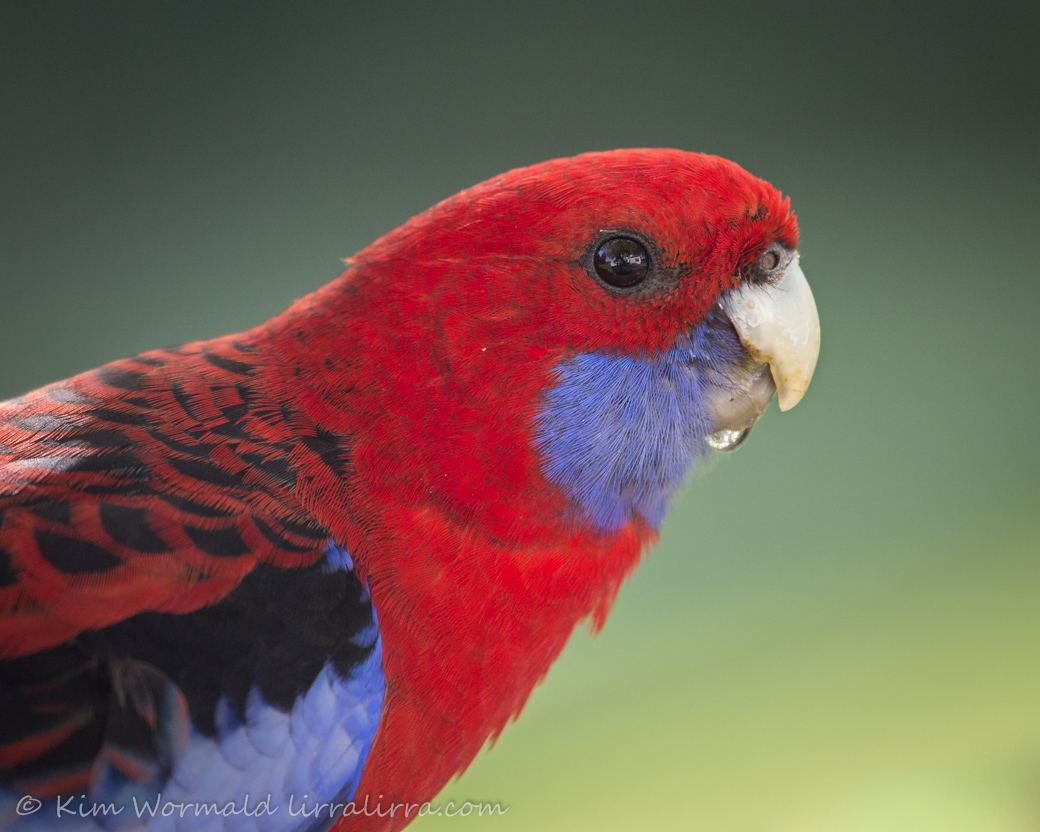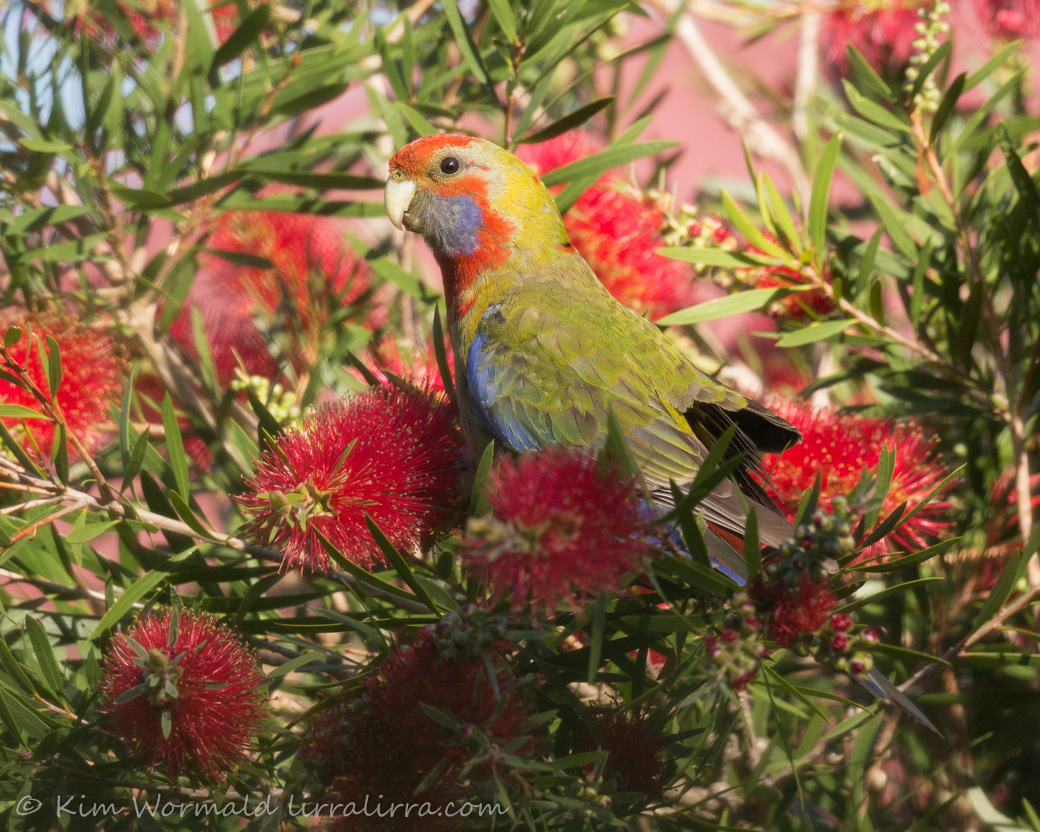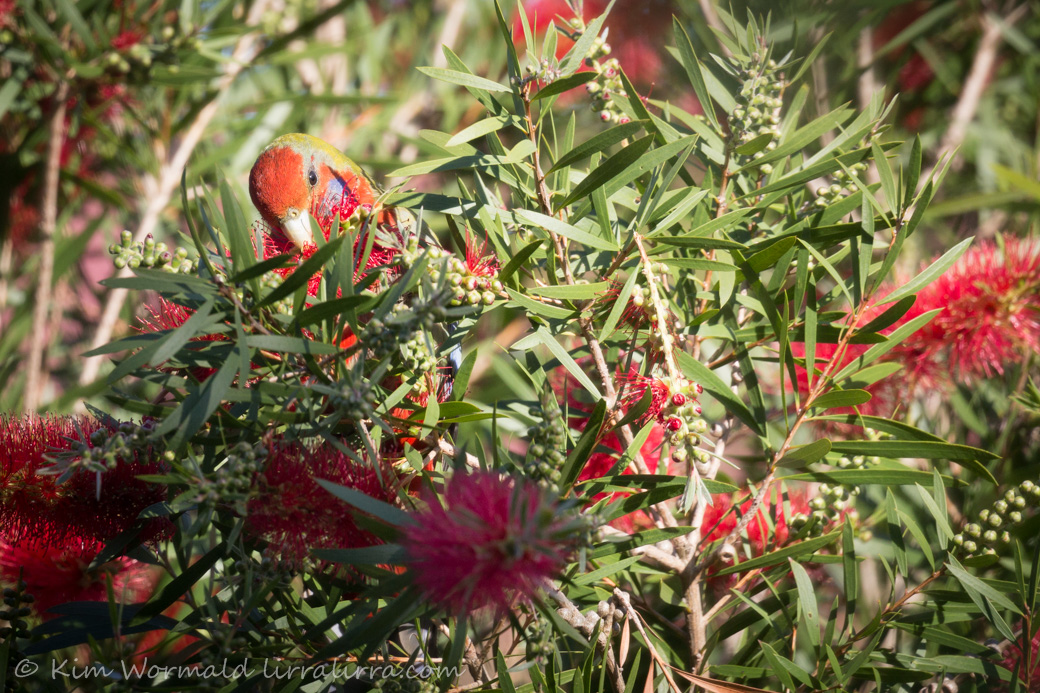Crimson Rosellas are often at my place, especially when the eight-year-old Wildlife Warrior is here.

Crimson Rosella (Platycercus caledonicus)
Canon 5DIII, 1/640, f/5.6, ISO 1600, focal length 400mm
Crimson Rosellas are one of 56 Australian parrot species, they are about 34cm long and weigh about 130g. Their feathers are predominantly crimson except where the birds occur around the Flinders Ranges where they are orange, and along the Murray and Murrumbidgee where they are yellow – the orange offspring appear where the crimsons and yellows meet. They all have bright blue cheeks, wings and tails while the feathers on their backs are broadly fringed with colour. They are beautiful birds that I think we often take for granted in the areas where they are commonly seen, from South Australia through Victoria and New South Wales and into parts of Queensland.
Crimson Rosella (Platycercus caledonicus) – juvenile
Canon 5DIII, 1/1600, f/5.6, ISO 800, focal length 400mm
Juvenile Crimson Rosellas are greenish-olive apart from their blue cheeks; people often mistake the youngsters for a separate species. I never tire of the magic of seeing a small flock of crimsons fly into shrubs and trees and disappear despite their bright colours. I called it ‘colourful camouflage’ in an earlier post about Rainbow Lorikeets.
Crimson Rosellas feed on seeds and blossoms supplemented with insects. They are usually spotted in eucalypt forests, feeding or nimbly flying through the trees. They nest in hollows which can be an issue if Common (Indian) Mynas or Common (European) Starlings are in the area. A few years ago I was watching a pair of crimsons setting up a nest in hollow. They’d visited several times, taking turns to go inside and inspect the space. One crimson was inside the hollow while the other was perched on the rim peering at its mate when a Common Myna flew in, pushed past the crimson and chased both rosellas away from the hollow.
 Crimson Rosella (Platycercus caledonicus) – juvenile
Crimson Rosella (Platycercus caledonicus) – juvenile
Canon 5DIII, 1/1600, f/5.6, ISO 800, focal length 400mm
Crimson Rosellas and other birds from the parrot family can be attracted to bird feeding trays in gardens and parks, and sometimes become tame enough to land on people who are offering seeds. There has been a lot of talk online recently about whether wild birds should be artificially fed – despite the comments being in print it’s clear that people on both sides were raising their voices. On the pro side people enjoy seeing the birds up close, it strengthens their bond with nature and they truly believe they are doing no harm. I used to be in that category but soon learned that it is far better to plant trees and shrubs that attract the birds, and to supply clean water rather than food. Psittacine Beak and Feather disease is a life-threatening illness that affects parrots and causes feather loss and grossly deformed beak growth. This devastating virus is highly contagious and easily spread by the poop, crop contents and feather dust that builds up at and around feeding stations. Tiny hatchlings can also be infected and nesting hollows can remain contaminated for many years. There is no cure for the illness though occasionally a bird survives only to become a carrier, spreading the virus and infecting other birds.
Psittacine Beak and Feather disease doesn’t affect humans but another parrot disease, psittacosis, occasionally does; psittacosis is also known as parrot fever. It’s a serious, but thankfully rare, illness and doctors recommend taking care not to inhale dried secretions when handling parrots or cleaning feeding tables.

Crimson Rosella (Platycercus caledonicus) – juvenile
Canon 5DIII, 1/1000, f/6.3, ISO 800, focal length 400mm
There are also concerns about birds not foraging appropriately in the wild when food is offered at feeding stations. So many people vigorously ridiculed this notion, stressing that the birds come and go from their verandas and clearly forage in the wild – so many people, in fact, that I can’t help but wonder if the birds are getting breakfast at one place before flying to another home a couple of streets away and so on through the day. The issue here is that the birds will not be getting appropriate nutrition. Parrots are particularly fond of sunflower seeds and will carefully pick them out of a selection of mixed seeds but this can result in deficiencies in amino acids and calcium resulting in metabolic bone disease causing fractures, weakness and shaking. It also affects the viability of eggs as the shells are often too thin to sustain the embryo. There are other conditions directly related to inappropriate feeding including heart failure, obesity and the wing deformity commonly known as ‘angel wing’.
In some places artificial feeding supplies a vital supplement to birds that would otherwise not survive, particularly after bush fires or during harsh winters where habitat destruction has reduced the availability of natural food but apart from that I think we’re all better off creating bird-friendly gardens. I’m passionate about birding ethics and if you are too you might be interested in joining the facebook group where I’m one of the admins: Ethical Bird Photography
And to revisit my first sentence, the eight-year-old Wildlife Warrior has just started a blog and, if you have a spare moment, I know that encouraging comments would be appreciated – Wildlife Warrior Blog
Happy birding, Kim
~ Thank you for visiting and commenting
~ If you would like a weekly email letting you know that lirralirra has been updated please use the ‘subscribe’ box above right


I live near Burrinjuck Dam and have had a family of Crimsons (probably all different) in my yard each morning and evening for the last 8 years. I do NOT advocate feeding native animals and don’t do so, other than my resident shingle backs, they love strawberries and apples, but I dont feed strangers, (unless rare or endangered). I do have, however, lots of water bowls which were originally (and still are) for the native bees. The bowls are shallow and filled with stones so the bees don’t drown and therefore require many top-ups during the peak of summer but the parrots also use them twice a day. I use sprinklers for the thousands of passerines but the parrots love those too. I only use water. Not food. I have winter and summer flowering grevillias, various bottle brushes, a huge number of native bee (and honey bee) loving plants like agastacia, rosemary, salvias of all sorts and pineapple sage. I am not educated enough to be able to supply all of the diverse wildlife I my huge yard so I will continue to grow what I can and provide water.
Firstly Samantha I must apologise for not responding to you comment earlier, it must have been lost in the flurry of last year’s busyness. Your garden sounds fabulously delightful for you and your many wild visitors. I’m looking out onto three water bowls as I write to you and am thinking how grateful our visitors will be for water during the current hot spell.
This is so brilliant and so clear and informative ! Photos are superb as always !
Thank you Catarina 🙂
Hi,Kim. OT I know, but Eremaea Bird Sightings has a Channel-billed Cuckoo at Warburton, 29th Jan. Worth following up, perhaps–if your hearing can cope! Cheers, JB
That’s interesting! There was something in The Basin the other day, I saw a group of bird photographers setting up as I drove past, couldn’t stop and check it out unfortunately! I haven’t seen anything added to Eremaea about that yet. Please let me know if you visit the cuckoo.
Beautiful photographs and very interesting information.I love watching them in our ferns and silver birch tree.
They’d look like blossoms among the greenery 🙂
A post to make me think. Again.
I do love the crimsons. Well all of our birds.
And we feed them. We also plant things which we hope they will find attractive. And some things which they DO find attractive and I wish they didn’t (tulips for one).
Beak and feathers is a cruel, slow death though…
Off to visit the Wildlife Warrior.
It would be good to know how long the PBFD virus can live outside of an infected bird, then we’d know that not feeding for a few days (or however long it is) would mean the area was clear of the virus, as long as the birds didn’t visit on the off-chance. The other way is with cleaning, but being mindful of psittacosis. I know you care about birds EC, as do all feeders. It’s great that you have a bird attracting garden, sorry to hear about your tulips – catching them at it would make an awesome photograph!
The rosellas are so lovely and I so enjoy that your posts are not only pictures of the amazing species you have there but also so very informative. Gotta go check out the warrior’s blog just for fun now!
The wildlife warrior was stoked to have people looking at the site, thank you!
I really really love this post! One of my favourite birds and beautiful pictures!!
I’m so pleased you enjoyed the post Rachel!
Their camouflage is so brilliant! Really beautiful photos and a very informative read.
Thank you Alyssa 🙂